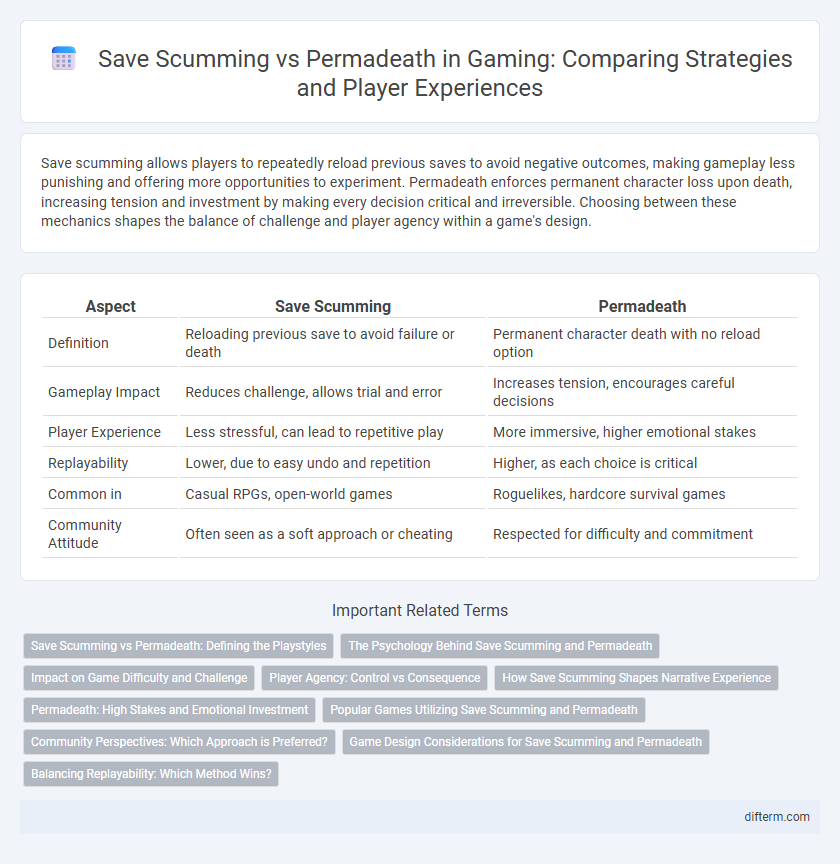Save scumming allows players to repeatedly reload previous saves to avoid negative outcomes, making gameplay less punishing and offering more opportunities to experiment. Permadeath enforces permanent character loss upon death, increasing tension and investment by making every decision critical and irreversible. Choosing between these mechanics shapes the balance of challenge and player agency within a game's design.
Table of Comparison
| Aspect | Save Scumming | Permadeath |
|---|---|---|
| Definition | Reloading previous save to avoid failure or death | Permanent character death with no reload option |
| Gameplay Impact | Reduces challenge, allows trial and error | Increases tension, encourages careful decisions |
| Player Experience | Less stressful, can lead to repetitive play | More immersive, higher emotional stakes |
| Replayability | Lower, due to easy undo and repetition | Higher, as each choice is critical |
| Common in | Casual RPGs, open-world games | Roguelikes, hardcore survival games |
| Community Attitude | Often seen as a soft approach or cheating | Respected for difficulty and commitment |
Save Scumming vs Permadeath: Defining the Playstyles
Save scumming involves repeatedly saving and reloading gameplay to avoid negative outcomes, allowing players to manipulate game states for favorable results. Permadeath enforces permanent character death, increasing stakes by eliminating retries and promoting strategic decision-making. These contrasting playstyles shape the gaming experience by balancing player control against challenge intensity and emotional investment.
The Psychology Behind Save Scumming and Permadeath
Save scumming appeals to players' desire for control and mastery by allowing repeated attempts to alter outcomes, reducing anxiety and frustration associated with failure. In contrast, permadeath heightens emotional investment through irreversible consequences, fostering a deep sense of risk and accomplishment. The psychological tension between these mechanics reflects players' differing preferences for security versus challenge in gaming experiences.
Impact on Game Difficulty and Challenge
Save scumming drastically reduces game difficulty by allowing players to repeatedly reload earlier saves to avoid failure, undermining the intended challenge and tension. In contrast, permadeath enforces permanent consequences for player mistakes, heightening stakes and creating a more immersive, high-pressure experience. This design choice fundamentally alters gameplay strategy, where permadeath increases skill demand and decision-making weight compared to the forgiving nature of save scumming.
Player Agency: Control vs Consequence
Save scumming empowers players with extensive control by allowing repeated retries to achieve desired outcomes, minimizing the impact of failure. In contrast, permadeath enforces permanent consequences, heightening player agency through meaningful decision-making and risk management. This trade-off defines the core tension between player control and the weight of in-game choices in gaming experiences.
How Save Scumming Shapes Narrative Experience
Save scumming fundamentally alters the narrative experience by allowing players to bypass permanent consequences, enabling repeated attempts to achieve preferred outcomes and story branches. This practice often diminishes the emotional weight and tension that permadeath systems impose, as the threat of irreversible loss drives more meaningful decision-making and character attachment. Consequently, save scumming can transform a game's storyline from a high-stakes journey into a more controlled, less impactful exploration of its narrative possibilities.
Permadeath: High Stakes and Emotional Investment
Permadeath amplifies the stakes in gaming by permanently erasing a character's progress upon failure, fostering intense emotional investment and heightened player immersion. Unlike save scumming, which allows players to reload from earlier points, permadeath demands strategic decision-making and consequence acceptance, enriching the gameplay experience. This mechanic deepens player attachment as every action carries irreversible weight, making victories more rewarding and losses more impactful.
Popular Games Utilizing Save Scumming and Permadeath
Popular games utilizing save scumming include "The Elder Scrolls V: Skyrim" and "Fallout" series, where players frequently reload saves to avoid unfavorable outcomes or mistakes. In contrast, titles like "Dark Souls" and "Hades" implement permadeath or limited save points to heighten challenge and encourage skill mastery, as dying resets progress or sends the player back to earlier checkpoints. These mechanics drastically affect gameplay strategy, influencing player immersion and the overall difficulty experience in role-playing and roguelike games.
Community Perspectives: Which Approach is Preferred?
Gaming communities remain divided on save scumming versus permadeath, with many valuing permadeath for its heightened challenge, increased stakes, and emotional investment. Save scumming, favored by casual players and completionists, offers the benefit of retrying difficult scenarios without permanent loss, promoting experimentation and learning. Competitive multiplayer forums often lean toward permadeath to preserve fairness and authenticity, while single-player communities exhibit more tolerance for save scumming as a way to enhance enjoyment.
Game Design Considerations for Save Scumming and Permadeath
Save scumming allows players to revert to previous game states, reducing frustration and encouraging experimentation, but it can diminish tension and challenge, affecting player engagement and pacing. Permadeath enforces permanent consequences, enhancing immersion and emotional investment by raising stakes, yet it risks player frustration and disengagement if perceived as overly punitive. Game designers must balance player agency, difficulty, and narrative impact when deciding between save scumming mechanics and permadeath integration to optimize player experience and retention.
Balancing Replayability: Which Method Wins?
Save scumming enhances replayability by allowing players to experiment with different strategies without fear of permanent consequences, fostering a dynamic and customized gaming experience. Permadeath, on the other hand, increases tension and immersion by imposing high stakes, which can limit retries but heighten the emotional investment in each playthrough. Balancing these methods depends on the game's design goals: save scumming favors exploration and learning, while permadeath prioritizes challenge and long-term engagement.
save scumming vs permadeath Infographic

 difterm.com
difterm.com